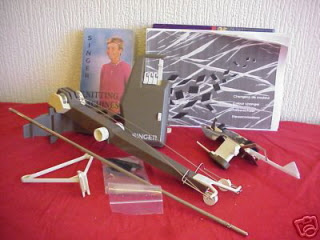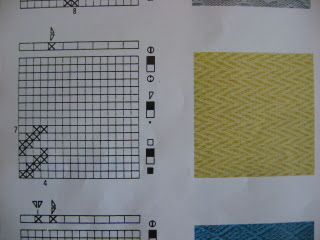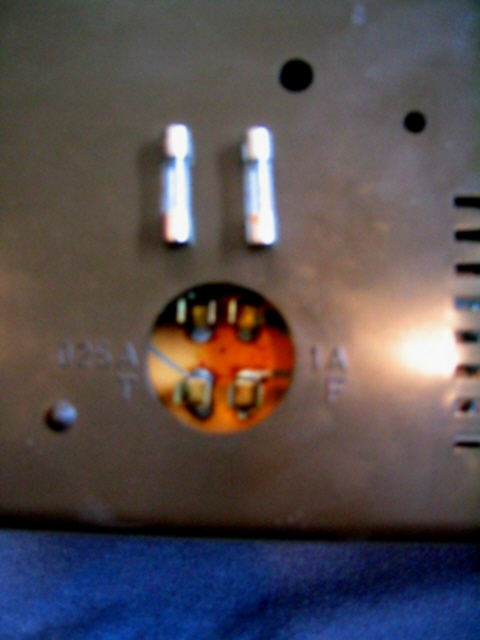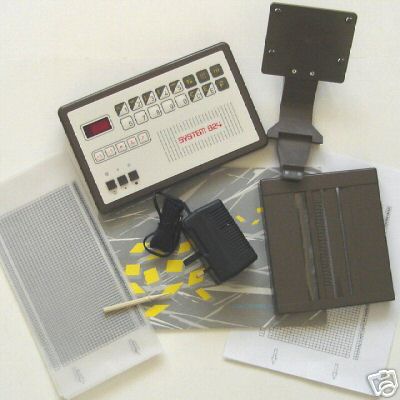Greetings!
This post reviews the various models of home knitting machines produced by S.I.T./Superba in Mulhouse, France.
 |
| My Superba model S48 Light Scanning Electronic Knitting Machine. |
What's In A Name?
Superba - Singer - White - Phildar
 |
| 1980's UK Advertisement For Singer Knitting Machines |
Commonly asked questions . . .
• "You say "SUPERBA" but my machine is labelled "WHITE?"
• "Sometimes you don't specify which model of knitting machine you are using?"
• "My Singer 2310 looks similar to your machines but mine is Red and White?"
• "Which Brand and Model are we dealing with?"
I live in Canada and up until the early 1980's, this style of home knitting machine was sold here in North America as SUPERBA. Then the distributor ceased operation and for a while these machines were not available here.
Then in the mid 1980's Husqvarna/WHITE, based in Ohio, started distributing the machines in North America only, using the WHITE brand.
Then Husqvarna/WHITE ceased distributing these French knitting machines and switched to distributing machines made in Japan as "Studio by White".
Confusing - yes.
When I began hunting around on the internet for Superba Machines, I joined the Superba/White Preservation Society, and through this online group I found out that Superba machines were sold in Europe as the SINGER© and PHILDAR© brands. So I searched out these machine brands and Wow! I soon discovered there were a huge variety of models and colours to be had. But only sold in Europe.
 |
| The Singer 'Club' Double Bed Model 2110. Only sold in France. |
I finally received my first French Double Bed Knitting Machine as a birthday gift in 2004. I was gifted a WHITE model 1502 by my sister, who went to pick the machine up for me but insisted on paying for it. How sweet is that?!

 |
| My First S.I.T./Superba Knitting Machine - the WHITE 1502 Double Bed Model. |
I had always coveted SUPERBA knitting machines since the early 1980's, when I saw a SUPERBA S47 model demonstrated at a trade show.
Since 2004 I have acquired five more of these fantastic knitting machines. Not to say that the process was free of frustration but the learning curve has been fascinating!
Why so many? Well, my first model worked just fine once I cleaned it up but the electronic stitch controller did not operate. I wanted a fully operational model. My second French Knitting Machine I acquired was the WHITE 1602 model, which was in wonderful shape but again, the electronics in the Light Scanning Selection Box were not working.
 |
| WHITE Model 1602 Electronic Light Scanning Selection Box. |
I decided to buy the machine anyway as with the purchase of that machine I now had a complete back-up of spare parts, including needles. And these machines are very rare compared to other brands.
Then a year later I found a Superba S48, with all the optional accessories, including the Superba table-top Motor Drive. I had this shipped from eastern Canada and was very nervous the whole time as I was afraid of it being damaged in shipping. This model had a previous life in a small knitting mill and was well worn but I was thrilled to bits when I attached the Selection Box and it it worked like a charm! I've knit a lot of garments using this little work horse of a machine.
 |
| Superba Model S48. |
A month after that I found another White 1502 model, this one in pristine condition and fully operational. So now I had two of each model of electronic Superba sold in North America; one with operational electronic programmers, and a back-up of spare parts to last a lifetime.
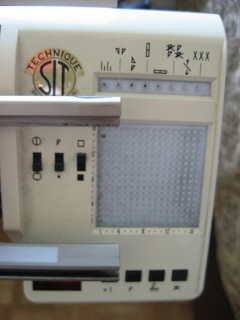 |
| WHITE Model 1502 Pressure Pad Progammer |
I later acquired the Single Bed Electronic WHITE 1402 Model from the United States . . .
and a White S9 Hobby Knitter Model . . .
 |
| My WHITE S9 Hobby Knitter. |
In 2006 I began my search for a Singer System 9000 and System 624 model knitting machine, the two last machines introduced and produced by Superba before they ceased production. These were only available in Europe.
I had seen advertisements and read articles in machine knitting magazines from England for both these models and later found out that this model was introduced briefly to North America but removed from the market apparently due to problems with mis-patterning caused by static electricity and power fluctuations in our electricity supply. So I had to search in Europe to find one and to source a reputable seller.
The features of the machine sounded great: being able to draw garment shapes and to insert stitch designs anywhere using the interactive CAD Programmer that was the System 9000. I had to have one!
I first acquired the 4 Colour Yarn Changer that was developed for the System 624/9000 model knitting machine, oddly from a seller in the United States who had bought a machine from the UK and had a spare.
Then in 2007 I purchased a System 624 Electronic Programmer from a Mr. Tony Lewy in England. I bought this for future use, knowing I would one day acquire the System Knitting Machine to attach it to.
Then in 2008 I bought a Singer System 9000 model knitting machine, again from Tony Lewy in England and had it shipped to Canada. Tony does a great job of shipping and packaging the machines and they arrive in great shape, ready to go.
 |
| My Singer System 9000 Model Knitting Machine with 4 Colour Yarn Changer. |
Superba Knitting™.
Now all through this process I was trying to find information on the internet about this style of French Knitting Machine and essentially there was none, save the few pictures on the White/Superba Preservation Society page.
I was also receiving email request for information from contacts I did have online, so I decided to put what information I could gather up onto the world wide web for all to access.
When deciding on what to name this information blog, I decided to keep things simple and refer to all these machines as SUPERBA.
That's what they are in my mind.
And in 2005 I began Superba Knitting™, which is my trademark.
That's what they are in my mind.
And in 2005 I began Superba Knitting™, which is my trademark.
I truly wish I had more time to put up information in the way I would like to see it, including video - but time is scarce. I do my best.
S.I.T./Superba Worldwide Brand Names
S.I.T./Groupe Superba of Mulhouse, France produced and marketed knitting machines worldwide under various brand names.
All of the machines and most accessories, regardless of brand, will have the following logo on them:
S.I.T. means Standardisation Internationale de Tricotage or International Standardization of Knitting.
Superba achieved this standardization with all their models of knitting machines. I can assure you of that. All the double bed models I own including brand names Superba, White and Singer use the same size needles, the same Carriages, the same tools and accessories and one operates them and creates knitwear on each one in the same manner.
The difference between models is the style of Electronic Stitch Programmer the particular model came with.
 |
| Note the S.I.T. Logo in the upper left corner. |
There is a lovely consistency of design built in to every S.I.T./Superba machine.
The information presented on this website applies to owners of home knitting machines that have the following names and/or logos printed on their machines:

Superba knitting machine model numbers included the:
• The Superba S44 Peg Board Electronic Selection Box Model. This was the worlds first Electronic home knitting machine.
The Single Bed version was the S42.
• Superba S48 Electronic Light Scanning Selection Box Model.
The Single Bed Version was the S46.
• The Superba S47 Electronic Pressure Pad Model.
• The Superba System 624 Model Knitting Machine.
• The Superba System 9000 Model Knitting Machine.

The WHITE™ brand was distributed only in North America and these models were all beige in colour - exact copies of the machines distributed as the 'PHILDAR' brand.

WHITE™ brand models included:
The WHITE 1602 Light Scanning Selection Box Model.
The WHITE 1502: The Pressure Pad Programmer Model.
The White 1402 Single Bed Pressure Pad Programmer Model.
The WHITE S9 Bulky Yarn Hobby Knitter: This is a 9mm Gauge Plastic Bed Knitting Machine for use with thicker hand knitting yarns.
The WHITE Easy Knitter - A 5mm Gauge Hobby Machine For Finer Yarns.
My White Brand "Model 1502" Double Bed Electronic Knitting Machine.
|
In the 1980's Husqvarna/WHITE, based in Ohio, started distributing the machines in North America only, using the WHITE brand.
Husqvarna/WHITE ceased distributing these French knitting machines and switched to distributing machines made in Japan as "Studio by White".
The SINGER™ Company** was by far the biggest client and seller of Superba Knitting Machines.
**Note: In North and South America, the SINGER Company distributed home knitting machines produced by the Silver Reed Company of Japan - a completely different style and format of knitting machine, shown in the photo below.
 |
| Singer 'Cocktail' Double Bed Model. Sold Only In France. |
In France the colours of the SINGER Knitting Machines were often paired with a model of Singer Sewing Machine for a consistent look for a particular range of machines.
Click on this link to take you to videos of television commercials from France the 70's and 80's showing SINGER knitting machines.
• SINGER 2200 Peg Board Memomatic.
 |
| Singer Memomatic 'Peg Board' Electronic Model 2100. |
• 600/Memo II.
And a Single Bed Version the 400/Memo II . . .
• The Light Scanning Mylar Model Singer 2310 and 2340.
• Electronic Singer System Model with 624 Controller, sold in France as the MT2140 with 624 Controller.
• Electronic Singer System Model with 9000 Controller, sold in France as the Singer MT-700.
• Singer also had a 9mm Gauge Hobby Knitter for bulky yarns called the Singer Big 9 and SB 151.
• And the Singer 5mm Gauge Hobby Knitter for finer hand knitting yarns.
Of special interest to owners of all Superba, Singer, White and Phildar machines are the Phildar Knitting Magazines and publications.
Phildar magazines include, to this day, instructions for making their published designs using various models of S.I.T./Superba knitting machines.
You can order booklets directly from Phildar and also source older issues online.
PHILDAR Models included:
• The 'Big Phil' 9mm Gauge Hobby Knitter. This was a very popular machine model for PHILDAR as it accommodated most hand knitting yarns produced by the company, and there was excellent pattern support for this model in their knitting catalogues.
 |
| PHILDAR Big Phil Bulky Yarn Hobby Knitting Machine Model. |
• The Phildarmatic D110 Pegboard Model:
• The PHILDAR D115 Pressure Pad Model:
• The PHILDAR D120 Light Scanning Model:
Regardless of your particular model number of Superba, White, Singer or Phildar brand name knitting machine and regardless of when it was made, all these knitting machine brand names were manufactured by S.I.T./Group Superba® in France.
So I refer to them all as Superba. It keeps things simple!
 |
| Superba Electronic Stitch Controllers: Pressure Pad, System 624, Light Scanning Mylar |
How your particular Superba model creates fancy stitches may differ; some of you may have a model that is manually operated -
or you may have a machine with one of the various Electronic Programmers to automatically create stitch patterns -
The point to be made is that the Principal Parts and layout of all the various Double Bed model knitting machines produced by Superba are essentially the same.
The knitting machine beds and carriages all operate and function using the same components and controls.
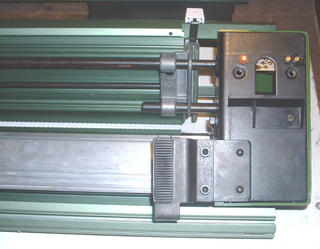 |
| Bottom View Of A Superba S48 Model Knitting Machine. |
All the Double Bed models S.I.T./Superba produced shared the same frame or platform if you will. They were made to be compact, light weight and easy to set up - which they are.
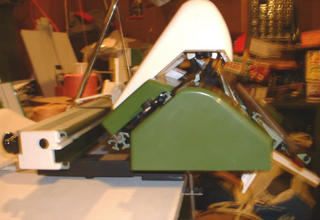
It surprised me how tiny they were when I received my first machine in comparison to the Japanese machines and really small in comparison to a Passap and yet they produce the most beautiful knit fabrics like this Plaited Jacquard knit on Model White 1502/Superba S47/Singer Memo II.
Most important was how easy it was to move the carriages back and forth. So light and effortless compared to other styles of home knitting machine. This makes a difference if you are physically challenged in anyway and also, when knitting long sections, there is less effort to moving the carriages.
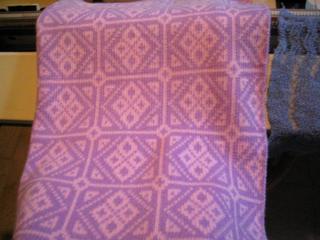 |
| Reversible Jacquard Worked On A White 1502 Model Knitting Machine. |
Look carefully and you will see the consistency of design and engineering built in to all Superba double bed models and maybe even spot your exact model of knitting machine.
Early S.I.T./Superba models have no automatic stitch patterning capabilities but by manually selecting needles every row by hand, they can work various stitch techniques such as Tuck, Slip, Single Bed Fair Isle and Double Bed Jacquard. Of course they excel at working Stocking Stitch and Ribs of all kinds. Socks, hats and gorgeous sweaters and knit suits can still be created using these early models of Superba.
Pictured is a Superba 360 ...


The Superba 360 (it had 180 needles on each bed - get it!) with the optional Motor Drive...

and the exact same machine labeled as a Phildar D-10.

Singer Manual Double Bed Machines
The Cocktail and Club Models
Superba produced specific models for the european division of the Singer Company which were sold only in France, to coordinate with specific models of sewing machines.
These inlcuded the Singer Cocktail model with Turquoise accents.
And the Singer Club model with cherry red accents.
Both were manual models that had no automatic programming other than basic 1x1 needle selection on the front bed only.
These inlcuded the Singer Cocktail model with Turquoise accents.
And the Singer Club model with cherry red accents.
Both were manual models that had no automatic programming other than basic 1x1 needle selection on the front bed only.
 and a Singer 2110.
and a Singer 2110.The Jacquard Knitting Machine Models - What Made Superba Famous!

Electronic Needle Selection
Technique S.I.T./Superba never marketed a punch card model knitting machine to control stitch patterns like other manufacturers.
Instead they developed knitting machines that used electronic needle selection for the creation of stitch designs exclusively.
The very first electronic home knitting machine produced was the Superba S46 Peg Board Knitting Machine back in the early 1970's.

Instead they developed knitting machines that used electronic needle selection for the creation of stitch designs exclusively.
The very first electronic home knitting machine produced was the Superba S46 Peg Board Knitting Machine back in the early 1970's.

Picutred above are just three examples of these controllers:
• On the left is a Pressure Pad Programmer.
• In the centre is a System 624 Programmer
• On the right is a Light Scanning Selection Box Programmer.
 These various electronic programming formats were developed over the years for creating automatic stitch patterns. Stitch patterns could be quickly programmed into the controller and depending on the model, various features were added which allowed for the ability to manipulate the stitch pattern by doubling the length and width, colour reversing and adapting to various stitch techniques.
These various electronic programming formats were developed over the years for creating automatic stitch patterns. Stitch patterns could be quickly programmed into the controller and depending on the model, various features were added which allowed for the ability to manipulate the stitch pattern by doubling the length and width, colour reversing and adapting to various stitch techniques.
• On the left is a Pressure Pad Programmer.
• In the centre is a System 624 Programmer
• On the right is a Light Scanning Selection Box Programmer.
 These various electronic programming formats were developed over the years for creating automatic stitch patterns. Stitch patterns could be quickly programmed into the controller and depending on the model, various features were added which allowed for the ability to manipulate the stitch pattern by doubling the length and width, colour reversing and adapting to various stitch techniques.
These various electronic programming formats were developed over the years for creating automatic stitch patterns. Stitch patterns could be quickly programmed into the controller and depending on the model, various features were added which allowed for the ability to manipulate the stitch pattern by doubling the length and width, colour reversing and adapting to various stitch techniques.
The flexibility to use both single and double bed capabilities from one design proved their investment in electronic patterning was a sound choice. No other brand of knitting machine is quite as flexible as a Superba in my opinion in the variety of knit fabrics they can create nor in the variety of yarns the machine can knit.
How Do I Identify My Electronic Model?
First of all, you will know you have an electronic model by identifying this Principle Part located on the back needle bed:
The Cursor.

The Cursor is used by the electronic model machines as a connection between your particular model's Controller, the needles and the Back Carriage. All three work in unison. The process works like this:



Once you are have entered your stitch pattern into the Programmer and flip the switch on your controller indicating you are ready to begin knitting the first row, an electric signal is sent from the stitch pattern controller through the needle bed itself.
This results in a low-level electric charge which is sent along the entire needle bed and the individual needles receive either a positive or negative charge, depending on the stitch pattern you are using.
As you knit your first row, the Back Carriage will pick up the Cursor using a black extension with small copper teeth known as the Cursor Block.

This forms a closed-loop electrical connection with the Cursor and together they will scan and counts each needle for a positive or negative charge.

So take care of your Back Carriage as on the underside are two sets of Magnets and two Cursor Blocks which extend from the carriage and engage the Cursor.

Once again: On a Superba Knitting Machine it is the Cursor working with the Back Carriage Magnets that will count and then select and channel the needles according to the signal sent through the needle bed from the Electronic Programmer. This happens each and every row.

To signal the end of a completed row Cursor Stops are placed at each end of your knitting. The Cursor Stops release the Cursor from the carriage at the end of every row you knit and in the process the Cursor sends a signal to your machines controller that it is ready to work the next row.

The Electronic Controller will then charge the needle bed with the next row of your stitch pattern. Then the Back Carriage will pick up the Cursor again and select the appropriate needles to work the next, according to this new pattern row and on following rows.
This system operates very quickly and efficiently.

So remember: On a Superba the Electronic stitch design that results is determined and manipulated by settings on the Back Carriage.
Depending on the stitch pattern, this can be used for all techniques including Tuck, Slip, Fair Isle, Weave Effect, Jacquard and more.

The Cursor.

The Cursor is used by the electronic model machines as a connection between your particular model's Controller, the needles and the Back Carriage. All three work in unison. The process works like this:
- You select a stitch design you want to knit. With some models the designs are printed on Mylar sheets.

- You insert the stitch pattern into your Programmer: in this example I am inserting a Mylar Stitch Design Sheet into the Selection Box . . .

- Before you even begin to knit you will use the Cursor to communicate with your models Programmer.
- Your machines Programmer will want to centre the stitch pattern on your knitting machine needle bed. Out of the 180 needles on your machine your electronic model Programmer will want to know where it should start knitting the first stitch of the first row, and then where and how to repeat the stitch pattern across the width of your knitting.
So we use the Cursor to program and centre our designs.

Once you are have entered your stitch pattern into the Programmer and flip the switch on your controller indicating you are ready to begin knitting the first row, an electric signal is sent from the stitch pattern controller through the needle bed itself.
This results in a low-level electric charge which is sent along the entire needle bed and the individual needles receive either a positive or negative charge, depending on the stitch pattern you are using.
As you knit your first row, the Back Carriage will pick up the Cursor using a black extension with small copper teeth known as the Cursor Block.


So take care of your Back Carriage as on the underside are two sets of Magnets and two Cursor Blocks which extend from the carriage and engage the Cursor.

Once again: On a Superba Knitting Machine it is the Cursor working with the Back Carriage Magnets that will count and then select and channel the needles according to the signal sent through the needle bed from the Electronic Programmer. This happens each and every row.

To signal the end of a completed row Cursor Stops are placed at each end of your knitting. The Cursor Stops release the Cursor from the carriage at the end of every row you knit and in the process the Cursor sends a signal to your machines controller that it is ready to work the next row.

The Electronic Controller will then charge the needle bed with the next row of your stitch pattern. Then the Back Carriage will pick up the Cursor again and select the appropriate needles to work the next, according to this new pattern row and on following rows.
This system operates very quickly and efficiently.

So remember: On a Superba the Electronic stitch design that results is determined and manipulated by settings on the Back Carriage.
Depending on the stitch pattern, this can be used for all techniques including Tuck, Slip, Fair Isle, Weave Effect, Jacquard and more.
Shown below is a Slip Stitch technique.

Below is Double Bed Jacquard.

It should be apparent then that the Cursor is a very important part to your machine and you should take care not to damage it and keep it clean from lint and oil.
Superba Electronic Model Double Bed Knitting Machines

"Peg Board" Electronic Selection Box Models.The First Electronic Knitting Machine.
Not having a Peg Board model in my collection I am relying on information supplied to me by George Le Warre about this style of Programmer:

". . . the "peg board" machine came a long time before the Pressure Pad and Light Scanning machines. I had one of these in the 80s, and it was then "old technology".
It was Superba's first ever patterning device, and was developed instead of punch card technology for their machines and was released in the early 1970s.

In many ways it works like a punch card in the programming, but the information is sent to the needles electronically. It was in fact the first ever electronic domestic knitting machine in the world, way before the Knitmaster/Studio Model SK500.
The Peg Board was 20 x 20 holes and each was programmed by inserting a black peg. Holes empty were not programmed. The knob on the left of the box moved the reading head up and down. Starting at the top, knit one row, then advance the knob one row moving the reader down, knit the next row.

This was the way the patten was knitted, advancing the reader manually row by row. The reader consisted of a row of 20 copper contact micro-switches which were operated by the row of pegs currently in use. When you advanced the reader to a new row the micro-switches were operated by the new row of pegs. So it was neither pressure pad, not light scanning, more "physically switched" selection by the pegs. Hope this explains it a little. "
I must say this sounds rather tedious compared to the speed of programming the Pressure Pad model that followed but at the time I am sure it was very advanced.


". . . the "peg board" machine came a long time before the Pressure Pad and Light Scanning machines. I had one of these in the 80s, and it was then "old technology".
It was Superba's first ever patterning device, and was developed instead of punch card technology for their machines and was released in the early 1970s.

In many ways it works like a punch card in the programming, but the information is sent to the needles electronically. It was in fact the first ever electronic domestic knitting machine in the world, way before the Knitmaster/Studio Model SK500.
The Peg Board was 20 x 20 holes and each was programmed by inserting a black peg. Holes empty were not programmed. The knob on the left of the box moved the reading head up and down. Starting at the top, knit one row, then advance the knob one row moving the reader down, knit the next row.

This was the way the patten was knitted, advancing the reader manually row by row. The reader consisted of a row of 20 copper contact micro-switches which were operated by the row of pegs currently in use. When you advanced the reader to a new row the micro-switches were operated by the new row of pegs. So it was neither pressure pad, not light scanning, more "physically switched" selection by the pegs. Hope this explains it a little. "
I must say this sounds rather tedious compared to the speed of programming the Pressure Pad model that followed but at the time I am sure it was very advanced.

Shown below is the Phildar version ...

and the Singer 2100.

Pressure Pad Programming Models

If I had to name my favourite model of Knitting Machine ever - it would be my White 1502 which is a Pressure Pad Electronic model.
 |
| My White Brand "Model 1502" Double Bed Electronic Knitting Machine. |
This popular model of machine was distributed as: Superba S47, Singer Memo II 600/611, Singer Freestyle Memo II and White 1502. Pictured below is a Singer Memo II as sold in Europe.
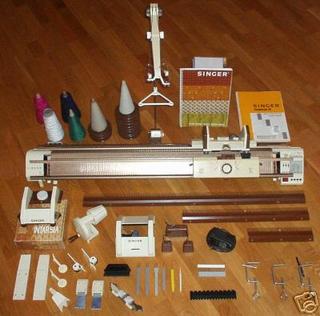
"Pressure Pad Programming" refers to the programming grid located at the righthand side of the machine. All the control functions regarding stitches are located here and this is where one enters a stitch design.
Pre-printed stitch patterns come with the machine as well as blank grid sheets to draw your own designs or those in the accompanying Stitch Pattern book.
The Programming process is very simple and done quickly:
• You begin by selecting a stitch pattern from the book or draw your own design. In this case I have selected this Vertical Chevron stitch pattern, which is shown in the manual for programming a Slip Stitch technique.
• Using an ordinary pencil you draw the pattern on a blank grid sheet. I print extras of these design sheets on my computer at home so I never run short or worry about making a mistake.
• You then insert this paper square into the Programmer under the perferated holes.
• Once you turn on the Programmer, it will prompt you to enter the number of stitches wide and rows in length for your stitch pattern.
• You will then use a stylus to enter the stitch pattern row by row, pressing on each of the grid holes where there is a stitch marked in pencil.
After setting the functions and controls as per the instruction book, your stitch design is then ready to knit .

The size of a stitch pattern is limited to either a maximum of 12 stitches wide x 16 rows in height or the reverse - a maximum 16 stitches wide and 12 rows in height.
You may say that that is rather small - what about all the 24 stitch patterns that I use on my Japanese Punchcard machines? What if the stitch pattern I want to knit is 30 stitches wide? Don't despair!
You may say that that is rather small - what about all the 24 stitch patterns that I use on my Japanese Punchcard machines? What if the stitch pattern I want to knit is 30 stitches wide? Don't despair!
The advantage of the electronics controlling the needle selection for stitch patterns on the Pressure Pad models is that one does not have to use the full width/height of the design as with punch card model knitting machines, where you must fill in the repeat in both direction over the whole card.

For example, this Fern design is a repeat of 12 stitches and 12 rows. That's all I have to enter onto the programmer. The electronics take care of everything else.
If the pattern repeat is only 4, 9 or 11 stitches wide and 3, 7 or 15 rows in height, then that is all you enter. There are limitations to the size and complexity of some designs but only if you want to do huge, overall or very long Fair Isle stitch designs. I have not been disappointed by the capabilities of this model!

As I mentioned, the Programmer has a row of Function Keys across the top which allows for true mirror imaging vertically and horizontally resulting in the ability to knit large pattern repeats, larger than what you could achieve on a punch card model machine and even some other top-of-the-line electronic brands.

That is how this flower pattern was knit - using the vertical and horizontal symmetry functions along with the double length function. The stitch technique is Double Bed Jacquard. All these functions are also used on the System 624 model knitting machine.
The electronics will instantly convert your design to any stitch technique if the design is applicable. One can quickly enter a new stitch design and knit successive patterns one after another including traditional Fair Isle or change the settings and knit using the Jacquard IV technique, which is the famous Superba Plaited Jacquard with a reversible fabric created whilst knitting two colours at one time .

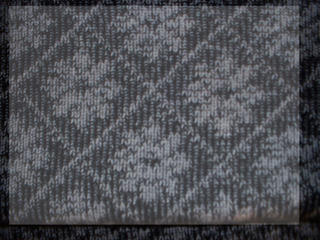
This is in addition to Jacquard with a solid colour back and on and on in terms of jacquard techniques. No other machine comes close to duplicating these styles of Jacquard. Over 50 Jacquard variations possible - in reality, about 5 or 6 that I really like and use.
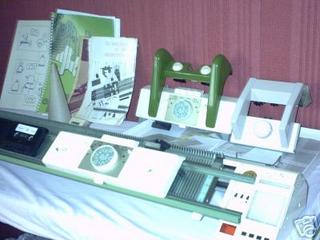 |
| Superba S47 Model. |
 |
| Singer Memo II/600 Knitting Machine Model. |
Below is my beloved White 1502 Pressure Pad model. I knit on this machine almost daily.It is very quick and easy to program stitch patterns and it handles all the hand knitting yarns I love to work with. Truly marvelous, dependable and knits the most beautiful fabrics and stitches of any knitting machine I have ever owned!

"Light Scanning" Selection Box Models
The Light Scanning Selection Box Models were introduced in the early 1980's and were sold as the Superba S48, The Phildar Memomatic, The White 1602 and numerous incarnations of the Memomatic brand name for the European division of The Singer Company including models 2310, 2331 and Freestyle 1.
This model evolved from the technology of the earlier Peg Board Programmer and was also inspired by the technology of Japanese manufacturers Silver Reed® and Brother® which had introduced Light Scanning models of their own. But S.I.T. expanded on this technology even further by developing two ways of reading and knitting stitch patterns.

 Please note that for models produced for the European division of The Singer Company®, changes to the colour of knitting machine carriages and the shape of the carriages was quite common even though the technical capabilities of the models remained the same.
Please note that for models produced for the European division of The Singer Company®, changes to the colour of knitting machine carriages and the shape of the carriages was quite common even though the technical capabilities of the models remained the same. 
Geometric and Decorative Stitch Patterns
The introduction of this model really solidified S.I.T./Superba's position as the masters of Jacquard knitting as this was the only brand of knitting machine to knit Jacquard using two colours at the same time every row (Yes Toyota had SimuKnit but the technique produced only one style of Jacquard).


Three distinct programming options for creating stitches using the same Selection Box allowed for a wide variety of stitch techniques to be produced using this great little machine.
A-Card Stitches:
These were simple, automatic 1x1 or every-other-needle stitches built into the Selection Box.
The "A" stands for automatic and there were 18 variations one could work utilizing all stitch effects the machine was capable of working including Weave Effect, Tuck, Slip, Fair Isle, double bed Jacquard and Tuck Rib.
One did not have to enter anything, beyond setting the switches on the control panel of the Selection Box, according to the directions on the A-Card.
 |
| A-Card Stitch Setting Instructions For The Selection Box. |
 |
| Setting The Selection Box Switches. |
 |
| A-Card Pattern A7: Single Bed Tuck Stitch + Yarn Sample. |
Geometric Stitch Patterns
Geometric Stitch patterns are drawn in a grid formation and came pre-printed on Mylar Pattern Sheets. A basic set of these came with the machine.
 |
| Pre-Printed Geometric Mylar With 6 Stitch Patterns |
You can purchase additional pre-printed sets of Geometric Patterns:
 |
| Additional Sets Of Pre-Printed Geometric Stitch Cards |
As well as blank sets of Mylar Sheets to draw your own designs.
 |
| Drawing My Own Geometric Stitch Patterns |
Geometric stitch patterns have a maximum pattern width of 60 stitches and the Mylar Sheet has to be filled in completely width-wise, so the number of stitches in your design must divide into 60: these would be repeats of either 2, 3, 4, 6, 10, 12, 15, 20, 30 or 60 stitches wide.
To knit these, the Mylar Sheets were inserted into a clear plastic programme card, and this was then inserted into the front of the Selection Box.
 |
| Mylar Design Sheet Inserted In Programme Card |
 |
| Light Scanners Below Numerical Scale On Selection Box. |
Once you set the front control panel according to the stitch pattern you wanted to create, the Selection Box scanned the stitch pattern row by row by using light scanners.

The stitch design, of appropriate, could be reproduced using any of the stitches the machine was capable of knitting including Tuck, Slip, Weave Effect, Fair Isle, Tuck Rib and many variations of Double Bed Jacquard (over 50 according to George Le Warre).
Stitch designs could be modified using the various function buttons on the front of the Selection Box to reverse colours and elongate stitch patterns.
Decorative Stitch Patterns
The stitch effect that really set these Superba Light Scanning model machines apart from any other knitting machine on the market was the 3rd stitch technique unique to Superba: Decorative Function.
Decorative patterns allowed for large, single motif stitch designs to be created by drawing the pattern on a thin, tissue-paper sheet. . .
which was then scanned at a very fine rate by the Selection Box, allowing the machine scanners and electronics to create a design up to the full width of the needle bed.
This feature was well in advance of any other manufacturer or the use of C.A.D. systems and it was years before any other manufacturer produced a machine with similar capabilities.
This technique is used primarily for 2 Colour Jacquard and large motifs can be worked out with precision as the width of 1mm drawn on the design sheet is translated into one stitch on the needle bed.
I've used this feature myself very extensively as I can calculate and draw complete designs to be used on a sweater front or for blankets.

All these great features were built into this compact and fantastic little knitting machine and this is without the additional cost of a computer and special software to operate it.
I own both a Superba S48 and a White 1602.
Note About The Selection Box Fuses and Internal Light Scanning Belt:
New owners or persons not having used their Light Scanning model in some time should open the box up to check the fuses, which may have blown and to check the condition of the Light Scanning Belt, which can break over time. The glue that joined the belts is what disintegrates over time, when not used regularly.
The Selection Box on my Superba S48 model works great, but my White 1602 Model is broken.
These units were made way back in the 1980's and so lack the sophistication of parts and controllers used in this century's electronics.
The Two Main Problems For A NonFunctioning Selection Box Are:
1. Blown Fuses. There are 3 Fuses altogether in the Selection Box.
• 2 Fuses are located on the back of the Selection Box by removing a small, round plastic cover.
The size of these Fuses are as printed; size 0.25A on the left, and size 1A on the right.
• 1 Fuse is located in the inside of the Selection Box.
You have to remove the cover and the single fuse is located at the bottom right. Size 1A.
Replacement Fuses are available at most electronic supply stores.
2. Broken Light Scanning Belt.
Replacement Light Scanning Belts are available from the Sew 'n Knit 'n Serge Outlet in Toronto, Ontario CANADA.
email: info@studioknittingmachines.
Belt Part no. 608 569.
Cost: C$38.50 each + freight and tax.
Phone: Toll free 1-800-836-6536 or Toronto Local at 416-752-1828.
I own both a Superba S48 and a White 1602.
Note About The Selection Box Fuses and Internal Light Scanning Belt:
New owners or persons not having used their Light Scanning model in some time should open the box up to check the fuses, which may have blown and to check the condition of the Light Scanning Belt, which can break over time. The glue that joined the belts is what disintegrates over time, when not used regularly.
The Selection Box on my Superba S48 model works great, but my White 1602 Model is broken.
These units were made way back in the 1980's and so lack the sophistication of parts and controllers used in this century's electronics.
The Two Main Problems For A NonFunctioning Selection Box Are:
1. Blown Fuses. There are 3 Fuses altogether in the Selection Box.
• 2 Fuses are located on the back of the Selection Box by removing a small, round plastic cover.
The size of these Fuses are as printed; size 0.25A on the left, and size 1A on the right.
• 1 Fuse is located in the inside of the Selection Box.
You have to remove the cover and the single fuse is located at the bottom right. Size 1A.
Replacement Fuses are available at most electronic supply stores.
2. Broken Light Scanning Belt.
Replacement Light Scanning Belts are available from the Sew 'n Knit 'n Serge Outlet in Toronto, Ontario CANADA.
email: info@studioknittingmachines.
Belt Part no. 608 569.
Cost: C$38.50 each + freight and tax.
Phone: Toll free 1-800-836-6536 or Toronto Local at 416-752-1828.
I will have to replace the fuses and the light scanning belt on the White selection box. For now I use my Superba S48 when I want to knit using a light scanning model.
Below is a photo of my Superba s48 - a great workhorse of a knitting machine and my second favourite knitting machine to knit on... although the System model from Superba that follows is giving it a run for it's money.

The System Model Knitting Machines:
System 9000/MT-700 and The 624.
In the late 1980's S.I.T./ Superba introduced the System Knitting Machine which was capable of using two distinct electronic stitch controllers:
The System 9000 Electronic Programmer.

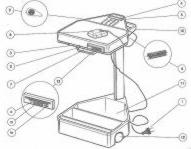



And the System 624 Stitch Programmer.

Pictured below is a photo of the System Knitting Machine that I own - note that it is exactly the same in looks and function as all my other Superba Knitting Machine frames with the exception that this unit has the ability to accept both the System 624 and the System 9000 Electronic Controllers. Both controllers are shown below.

System 9000
The System 9000 was Superba's last top-of-the-line model introduced by the company in the late 1980's.
The 9000 model featured the first fully integrated C.A.D. (Computer Aided Design) Program for a home knitting machine and represented a huge advancement in the use of computers to control the operation of stitches and garment shaping simultaneously.

The 9000 Controller was hooked up to a television monitor and stitch designs and garment patterns were created directly on screen.

Stitch patterns had no size limitations allowing for the creation of full needle bed designs.

This was the most sophisticated home knitting machine produced for it's time. Shown above, you can see the free standing controller in front of the knitting machine with a Mouse and diskettes used for entering garment and stitch patterns which appeared on a TV monitor.
One can access over 750 built-in stitch patterns, with hundreds of built-in garment shapes as well.
This allows the knitter total design freedom to place stitch designs where you want on your garment of choice, manipulate and alter them to your personal preference and all variations are displayed on the screen in the colour of yarn ahead of time.
Programming information is stored on a floppy disc format. This was way ahead of Design A Knit® for it's time.
 |
| Superba System 9000 Electronic Model Knitting Machine. |
The Singer Company® and Superba continued to sell these models in Europe until production ceased in the late 1990's.

This model was briefly sold in North America and then pulled from the market due to problems with mis-patterning due to variations in the North American power supply.
I have never seen one labelled as a WHITE version, and since I could not locate one here in North America, I finally purchased one in August of 2007 from Tony Lewy of East Sussex, England.
System 624
The second controller released by Superba before ceasing production altogether was the System 624.
This electronic stitch controller was based on S.I.T./Superba's popular Pressure Pad model but allowed for the use of 24 stitch wide patterns so that one could use any of the punch card patterns available for Japanese machines or easily create your own by drawing a design on plain paper, or accessing one of over 100 built-in stitch patterns.

The 624 came pre-programmed with 100 stitches and the programming functions were exactly the same as the 16x16 Pressure Pad models, allowing for horizontal and vertical symmetry as well as double length/width functions.
The added bonus of this model was that you did not need to use the full 24 stitches in width to program every pattern but could use a partial stitch repeat anywhere from 1 - 24 stitches. This would allow for stitch patterns up to 48 stitches in width when using one of the Symmetry functions.
I also the 624 Controller and I find it very quick and easy to enter stitch designs. I was also inspired to create my own grid pattern for drawing stitch cards using Microsoft Excel.
I have a basic blank template for the 624 that I created and I draw my stitch patterns directly on-screen and in colour.
I can check how the stitch pattern will repeat before printing off a copy and programming it into the 624 Controller.
I then keep these stitch designs in a file for later use.
And it has to be said, this is such an easy model to program. You only need to draw one repeat of your design - AND if the stitch repeat is such that only 1/4 of the design needs to be drawn, the electronic functions of horizontal and vertical mirror imaging can flip and repeat the design for you, so you don't have to spend time filling in a whole card. That's why only 1/2 of the Lion is drawn above, and only half the hearts are drawn below. The electronics will take care of the rest.
I also the 624 Controller and I find it very quick and easy to enter stitch designs. I was also inspired to create my own grid pattern for drawing stitch cards using Microsoft Excel.
I have a basic blank template for the 624 that I created and I draw my stitch patterns directly on-screen and in colour.
I can check how the stitch pattern will repeat before printing off a copy and programming it into the 624 Controller.
I then keep these stitch designs in a file for later use.
And it has to be said, this is such an easy model to program. You only need to draw one repeat of your design - AND if the stitch repeat is such that only 1/4 of the design needs to be drawn, the electronic functions of horizontal and vertical mirror imaging can flip and repeat the design for you, so you don't have to spend time filling in a whole card. That's why only 1/2 of the Lion is drawn above, and only half the hearts are drawn below. The electronics will take care of the rest.
Pictured below is the Singer brand System 624 as sold in the U.K. and Europe.

Below is a photo of the Singer "MT2340 with 624 Controller", as it was sold in France.

Superba also included their new 4-Colour Yarn Changer with sale of the 624 Model. It is attached to the left side of the machine below.

The 624 Programmer is portable and allows you to easily enter your own stitch designs, in addition to the numerous patterns already programmed into the unit.
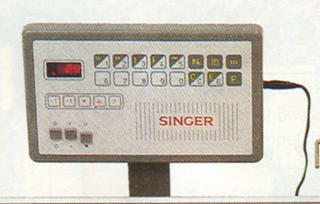
To my knowledge this model was never distributed in North America but only in Europe under the Superba and Singer Company® brand names.

Pictured below is my System Knitting Machine with the 624 Controller at the top right. I purchased the 624 Controller in May of 2007 and waited until August for the System Knitting Machine to arrive so I could attach the controller and use it.

I hope you enjoyed reading about these great machines and if you were unsure of the particular model of knitting machine you have, hopefully this post will help you identify which Superba, Singer, White or Phildar knitting machine you have.
Continued success with your knitting.
Patrick Madden
Toronto, Ontario CANADA
©2004-2010
Continued success with your knitting.
Patrick Madden
Toronto, Ontario CANADA
©2004-2010





